Johnny Cueto—who had a 2.62 ERA with the Reds before coming over to the Royals and a 4.76 ERA after coming over to the Royals—picks a good night to have a good night. Out of the Royal Blue, Johnny throws nine innings while giving up just two hits and one run and the Royals win 7-1 and go up 2-0 in the Series.
Nobody—and I’m pretty sure that includes the Mets and Johnny Cueto—saw this coming.
Cueto’s two-hit complete game also allows the Royals bullpen to rest which is a huge deal after the 14-inning marathon in Game 1.
Meanwhile, the Mets starting pitcher Jacob deGrom finds out just how hard it is to strike out the Royals. Despite repeatedly having Royals hitters in two-strike counts, deGrom only strikes out two of them. The Royals want to make the Mets play defense, so getting the ball in play is a high priority and nobody in the Major Leagues is better at getting the ball in play than the Royals and that’s going to turn into a Very Big Deal.
In the fourth inning Mets first baseman Lucas Duda (and I can’t believe his parent’s missed the chance to name him “Zip-A-Dee”) makes an error, but the Mets get away with it.
Sort of.
The Royals don’t score in the fourth, so we might think “no harm no foul” but errors mean more pitches thrown and an extra at-bat for somebody. We tend not to think that way, but an error in the fourth inning can mean an extra-plate appearance for the Number Three hitter in the ninth inning and that can matter a lot.
Fortunately for the Royals, Game 2 is decided four innings earlier than that.
The Bottom of the Fifth Inning
The Mets are winning 1-0 until the bottom of the fifth inning when Alex Gordon leads off with a walk.
Point of interest:
Lead-off walks are considered the worst kind of walk (OK, wait, that’s wrong—bases loaded walks are even worser) but lead-off walks are still pretty dang bad because the other team has all three outs available to move that lead-off walk around the bases. And a lead-off walk in the top of the fourth eventually turned into a run for the Mets and now deGrom has made the same mistake and walked Alex Gordon.
Next…
Alex Rios singles, Gordon moves to second, Alcides Escobar singles, Gordon scores, Zobrist grounds out, Cain lines out, then Hosmer singles and Morales singles and Moustakas singles and Perez ends the inning on a groundout, but by now it’s 4-1 and the Royals have all the runs they need, but they don’t know that yet and with Johnny Cueto on the mound (a pitcher who can go from All-Star to All-Done in a heartbeat) the Royals probably think they need more runs, which they’re going to get in eighth inning.
Timeout for Some Managing Strategy
In that fifth inning, starting with Alcides Escobar, the Royals were having their third at-bat against Jacob deGrom and third at-bats against a starting pitcher can be a game changer because now your hitters have seen what the starter has that night and how his pitches are moving (or not moving) and in 2015 deGrom’s opponents’ batting average went up the more often they faced him:
First plate appearance: .167
Second: .240
Third: .245
Fourth: .286
So why not pull deGrom early and refuse to let any lineup see him three times, which is a strategy that’s gained popularity.
In the 8th inning New York relief pitcher Jonathan Niese provides an answer. He gives up three runs and while I’ve pointed this out before it’s worth repeating; use enough relievers and you’re likely to find one that doesn’t have it that night and Niese doesn’t.
Game 2 Notes—or—Things Worth Noticing Because They’ll Come Up Again
Once again, Alcides Escobar swings at the first pitch he sees and this time he flies out to right field, but put that in your memory bank because it’s going to be an issue in Game 3.
Also…
In 2015 Esky swung at the first pitch of a plate appearance 220 times and when he put that first pitch in play, Alcides hit .364 and slugged .477, which is why he does it. Pitchers are trying to get ahead in the count by throwing first-pitch strikes, but Escobar’s aggressive approach is screwing up that plan and in Game 3, Mets pitcher Noah Syndergaard decides to do something about it.
During his first at-bat Daniel Murphy complains to home plate umpire Mark Carlson about missing pitches, but then strikes out on a called strike three and generally speaking it’s a bad idea to piss off the umpires you’re going to see for the rest of the series.
And according to the MLB website the only pitch Carlson missed was a strike he called a ball.
Your MLB Translator
If my lip-reading is any good (I can spot an F-Bomb from half-a-mile away in a dense fog) Murphy said “Let’s go!” to Carlson and what that means depends on when and to whom you say it.
If you say “Let’s go!” to your teammates it’s encouragement; if you say it to an umpire it’s criticism. Say “Let’s go!” to an umpire and you’re saying: “Pick it up—do your damn job!”
At one point Cueto comes up and in on Murphy, probably because Murphy’s standing on top of the plate, which makes pitches on the outside corner pitches down the middle and when a pitcher sees that he has to come inside and umpires have to let him.
In the fourth inning Salvador Perez comes to the plate with the bases loaded and two outs, takes an inside sinker for strike one and then chases a down-and-away fastball that has the same relationship to the strike zone that Ensenada, Mexico has to the United States—not even fucking close.
With runners in scoring position, batters get greedy for RBIs and smart pitchers will locate off the plate to see if those hitters will chase those pitches and in 2015 I wondered why anyone would throw Salvador Perez a strike and a decade later I’m still wondering.
Infield In or Back?
Here’s the deal on bringing the infield in: you do it with less than two outs and a runner on third base when one run matters and a manager has to decide if this run matters. If both teams are scoring runs in bunches, you don’t do it—you’ll have plenty of chances to score tonight; if the opposition pitcher is having a good night—runs are scarce—you do.
But with runners at second and third and one down in the fifth inning, the Mets do not bring the infield in even though the game’s tied and Cueto’s dealing.
Possibly because of the runner on second base; teams are sometimes reluctant to bring the infield in with two runners in scoring position. Bring the infield in and let a groundball get through and you’ve got a good chance of giving up more than one run.
Doesn’t help, Eric Hosmer still singles and the Royals score two more runs.
The Dangers of Playing Too Deep
In 2015 teams are using all kinds of weird infield positioning and it’s not unusual to see a second baseman playing deep on the outfield grass and a play involving Ben Zobrist shows how that can backfire.
The infield grass has two lips, the front lip and the back lip (where the dirt meets the grass) and groundskeepers try to keep those lips flat, but it’s not always possible, so it’s like having two speed bumps on the infield. When a ball hits a lip it’s not unusual to get a bad hop, but play your infielder deep enough and you double your chances of a bad hop and that’s what happens to Zobrist; he gets a bad bounce off the back lip.
I’m not sure how knowing when to bring the infield in or what deep positioning can do to an infielder improves your life, but the more you know the more interesting baseball gets and you’re going to see some of this stuff come up in this year’s playoffs…
WHICH START TOMORROW!
Next Up:
The Series goes to New York and it’s Noah Syndergaard against that Emotional Box of Chocolates (“You never know what you’re going to get”) Yordano Ventura.

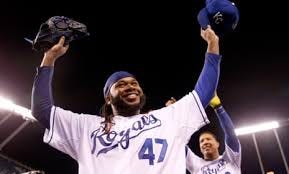
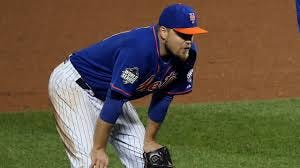

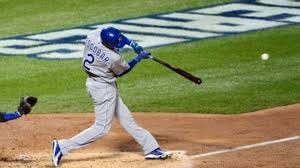
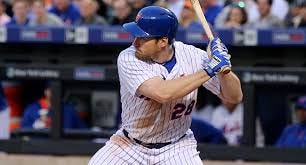
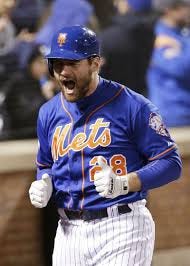
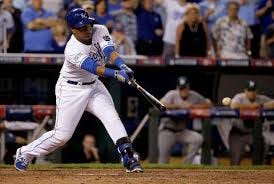

Karma gets Murphy for popping off. Murphy was hot as hell earlier in the playoffs. He should have been grateful for that, kept his mouth shut and his rear end down, as Mr. J will illustrate soon.
Salvy still goes after crap down almost in the dirt. He is a pretty good hitter, I don't get why he continues to do that.